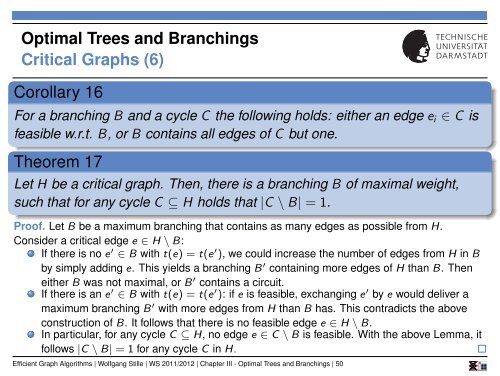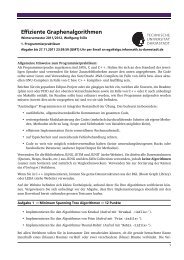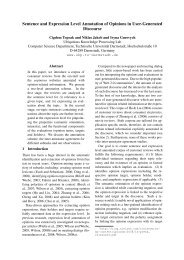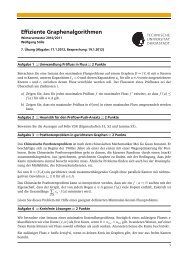Chapter 3: Optimal Trees and Branchings - UKP
Chapter 3: Optimal Trees and Branchings - UKP
Chapter 3: Optimal Trees and Branchings - UKP
Create successful ePaper yourself
Turn your PDF publications into a flip-book with our unique Google optimized e-Paper software.
<strong>Optimal</strong> <strong>Trees</strong> <strong>and</strong> <strong>Branchings</strong><br />
Critical Graphs (6)<br />
Corollary 16<br />
For a branching B <strong>and</strong> a cycle C the following holds: either an edge e i ∈ C is<br />
feasible w.r.t. B, or B contains all edges of C but one.<br />
Theorem 17<br />
Let H be a critical graph. Then, there is a branching B of maximal weight,<br />
such that for any cycle C ⊆ H holds that |C \ B| = 1.<br />
Proof. Let B be a maximum branching that contains as many edges as possible from H.<br />
Consider a critical edge e ∈ H \ B:<br />
If there is no e ′ ∈ B with t(e) = t(e ′ ), we could increase the number of edges from H in B<br />
by simply adding e. This yields a branching B ′ containing more edges of H than B. Then<br />
either B was not maximal, or B ′ contains a circuit.<br />
If there is an e ′ ∈ B with t(e) = t(e ′ ): if e is feasible, exchanging e ′ by e would deliver a<br />
maximum branching B ′ with more edges from H than B has. This contradicts the above<br />
construction of B. It follows that there is no feasible edge e ∈ H \ B.<br />
In particular, for any cycle C ⊆ H, no edge e ∈ C \ B is feasible. With the above Lemma, it<br />
follows |C \ B| = 1 for any cycle C in H.<br />
Efficient Graph Algorithms | Wolfgang Stille | WS 2011/2012 | <strong>Chapter</strong> III - <strong>Optimal</strong> <strong>Trees</strong> <strong>and</strong> <strong>Branchings</strong> | 50








